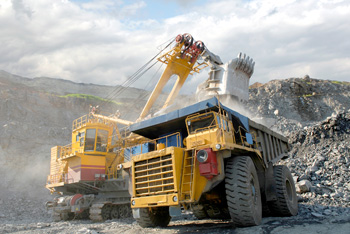March 20, 2013 – The iron mining bill, the subject of much controversy last year, was revived as the first order of business for the state legislature this session.
2013 Wisconsin Act 1 (Act 1) was signed into law on March 12, 2013, and contains many provisions from the failed AB 426 last year. Act 1’s stated intent is to promote new mining enterprises and expand the mining industry in Wisconsin. But Act 1 will face challenges by those claiming the new law seriously impedes environmental protections.
Under previous law, all metallic mining operations were required to obtain permits and meet the standards found in Wis. Stat. Ch. 293 and the rules promulgated thereunder.
At the heart of Act 1 is a sweeping reform to the environmental regulations that apply for siting an iron mine and mining waste site. Act 1 also seeks to ease the permitting process and financial liabilities for iron mines by imposing deadlines for permit review and contested case hearings, changing applicable fees and taxes, and diminishing available recourse for illegal environmental damage caused by the mine.
 Elizabeth Wheeler, Pace University School of Law 2006, serves as the staff attorney for Clean Wisconsin, an environmental advocacy organization. Wheeler focuses in Clean Air Act and Clean Water Act issues as well as policy and legislative analysis. She can be reached by email or at (608) 251-7020.
Elizabeth Wheeler, Pace University School of Law 2006, serves as the staff attorney for Clean Wisconsin, an environmental advocacy organization. Wheeler focuses in Clean Air Act and Clean Water Act issues as well as policy and legislative analysis. She can be reached by email or at (608) 251-7020.
The revised standards are found in Chapter 295, Subchapter III. The main provisions of Act 1 are described below:
Act 1 Relaxes the Environmental Standards for Siting a Mine and Waste Site
Applicants for an iron mining permit do not need to demonstrate the successful operation and reclamation of a mine without creation of acid mine drainage as required for other metallic mining operations under Wis. Stat. section 293.50.
Previous law required impacts to wetlands from all types of metallic mining to be de minimis, prohibited the filling of special or unique wetlands, and limited wetland impacts to five acres or less. Act 1 removes these restrictions on impacts to wetlands for iron mining facilities and allows impacts, including substantial adverse impacts to wetlands, so long as those impacts are offset by mitigation.
Act 1 also creates a presumption that impacts to wetlands are necessary in order to conduct iron mining. Applicants can exercise riparian rights by leasing or obtaining an easement on riparian property, a practice that is generally prohibited under Wisconsin’s navigable waters law. Act 1 also includes the following provisions:
It requires the Wisconsin Department of Natural Resources (DNR) to consider measures to offset impacts to navigable waters, including public rights or interests in navigable waters, or impacts to water quality or quantity when determining whether to authorize a navigable water activity;
It requires the DNR to site high-capacity wells to accommodate the mine, and to consider offsets or mitigation for impacts of high-capacity wells to navigable waters; and
It expands the groundwater “design management zone” and removes certain restrictions on siting for solid waste disposal facilities.
Act 1 Changes the DNR Review Process for Considering a Permit Application
Previous law required the mining permit hearing to be treated as a contested case. Act 1 downgrades the master hearing to a public informational hearing.
Act 1 also requires a mining permit to be issued within 420 days after a permit application is found to be complete, and allows the DNR and the applicant the ability to agree to one 60-day extension of this deadline.
Act 1 Limits Legal Recourse for Environmental Damage
Act 1 allows any individual who would be entitled to a contested case hearing under Wis. Stat. section 227.42 to request a contested case hearing on a decision by the department related to a mining permit, including a decision related to the environmental impact statement. The new law also requires a decision to be issued in a contested case hearing 150 days after the DNR issues a permit.
 If no decision is reached in the contested case hearing by that deadline, the contested decision is automatically affirmed. Act 1 also limits the authority of an administrative law judge to issue a temporary injunction to stop mining while the contested case hearing proceeds.
If no decision is reached in the contested case hearing by that deadline, the contested decision is automatically affirmed. Act 1 also limits the authority of an administrative law judge to issue a temporary injunction to stop mining while the contested case hearing proceeds.
In addition, judicial review actions relating to a mining permit decision must be brought in circuit court for the county in which the majority of the bulk sampling, mining, or exploration will occur. Act 1 also removes the right of a citizen to file a lawsuit directly against the mining company for a violation of the law.
Act 1 Changes Fees and Taxes
Under previous law, the applicant was required to pay all DNR costs associated with obtaining the mining permit. Act 1 caps the costs that must be paid by an applicant at $2 million plus any additional costs associated with a contractor hired to prepare an environmental impact statement and any costs associated with an application for a Great Lakes Diversion. The new law exempts iron ore mining facilities from the recycling fee portion of tipping fees and diverts 40 percent of the net proceeds occupation tax from the local impact fund to the statewide general fund.
Despite Best Efforts, Iron Mining Not Guaranteed
Those most concerned with the passage of the mining bill have focused on the potential for Gogebic Taconite to mine a substantial ore deposit in the Penokee Range in northern Wisconsin. However, even Act 1’s substantial revision to Wisconsin’s mining law doesn’t guarantee that Gogebic Taconite will be able to mine the ore there.
Significantly, the potentially affected area includes federal wetlands that are subject to Environmental Protection Agency and Army Corps of Engineers jurisdiction, meaning that any permittee will have to conform to federal wetlands standards and that a federal environmental impact statement will need to be prepared for the project.
Additionally, the mining operation must obtain federal Clean Water Act and Clean Air Act permits and show that it can meet the Bad River Tribe’s recently adopted water quality standards under the Clean Water Act.
The Penokee Range area is home to exceptional resource waters, trout streams, and the Kakagon and Bad River Sloughs, which are listed on the Ramsar list of wetlands of international importance, making it one of the most environmentally sensitive areas of the state.
In short, even with the changes to environmental regulations for wetlands and impacts to water bodies under Act 1, any company hoping to mine the Penokee deposit will have an uphill battle to show that the mining can be done in an environmentally responsible manner.
Related
